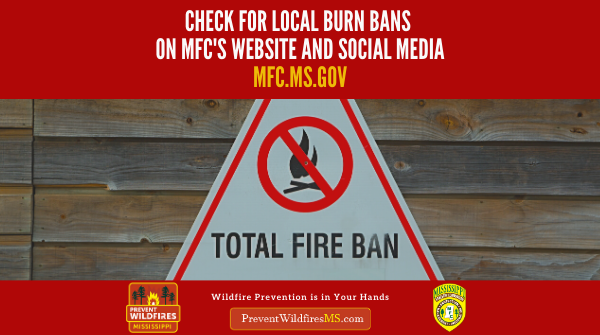MFC Encourages the Public to Remain Aware of Weather-Related Wildfire Danger

MFC is asking the public to remain attentive and comply with burn bans to prevent wildfires. The partial state-level burn ban is still in effect, and several other counties have implemented burn bans. October is typically one of the driest months of the year. Due to extreme drought conditions in August, the state experienced an earlier and heightened season of erratic wildfire activity. Since August 1st, the MFC has responded to over 1,030 fires, which burned over 16,000 acres. MFC wildland firefighters and their partners have protected approximately 1,885 structures from wildfires.
Some recent rainfall has provided some relief by reducing the presence of critically dry fuels across the Lower Mississippi Valley. Consequently, fire danger indices have improved. However, a concerning trend is emerging following a dry frontal passage, which poses a renewed risk of reburn and potentially challenging-to-contain wildfires in central and southern Mississippi.
While there are indications that El Niño may bring more rainfall towards the end of October, it is important to acknowledge that the damage caused by the drought and the underlying dryness will persist until then. The impact of the drought is evident across the state, with reports of pine mortality in central and southwest Mississippi extending into Louisiana. MFC Fire Chief Randy Giachelli explains, “Experts describe the drought’s effects as the most severe in at least a generation. Pervasive dryness throughout the Mississippi River Basin has resulted in low water levels, allowing wildfires to encroach upon hardwood river bottoms in parts of Mississippi. Additionally, our deciduous trees are shedding leaves early due to the drought. However, the area at most risk continues to be pine forests and the underlying southern rough.”
The Keetch Byram Drought Index (KBDI) currently hovers near its historical maximum, indicating the persistent risks associated with underlying drought. KBDIs in the central and south Mississippi areas remain above the 97th percentile.
Critical fire weather conditions may arise from various factors, including dry cold fronts followed by windy and dry conditions, strong high pressure over the northern U.S. combined with low pressure south of the advisory area, subsidence adjacent to tropical cyclones, sea breeze fronts, and erratic winds associated with outflow from nearby thunderstorms.
Giachelli states, “Please remember that 9 of 10 wildfires are human-caused. The slightest spark can cause a wildfire. Even small things like throwing cigarette butts out of a car, dragging chains, or other towing mechanisms down the street behind a vehicle can cause a fire. If you start a fire, you can be held accountable or fined for damages.”
To stay informed about burn bans and obtain valuable tips for wildfire prevention, please visit the Mississippi Forestry Commission’s website at mfc.ms.gov.
